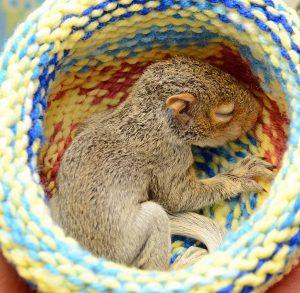What To Do If You Found Sick or Injured Baby Squirrel
About Baby Squirrels
A squirrel who is nearly full-sized, has a full and fluffy tail and can run, jump and climb is independent. However, if a juvenile squirrel continuously approaches and follows people, then mom is probably gone. In this case, you should contact a licensed wildlife rehabilitator because the baby is very hungry and needs care.
There are a few cases where you might need to intervene:
- A baby squirrel falls from a nest
- A nest falls from a tree
- A felled tree contains an intact nest
- If the baby and/or their nest fell from the tree today, give the mother squirrel a chance to reclaim the young and relocate them to a new nest. If the baby is uninjured, leave it where it is, leave the area, keep people and pets away, and monitor it from a safe distance.
- If it’s chilly outside or the baby isn’t fully furred, place it in a shoebox or other small container with something warm underneath (like a hot water bottle). Be sure to place something soft (old towel, T shirt) between the baby and the heating device, or it could overheat. Do not cover it with anything or the mother might not be able to find it.
- If the babies are not retrieved by dusk, take these steps:
- Wearing thick gloves, gather the squirrel(s) and place them inside a thick, soft cloth, such as a cloth diaper or fleece scarf or hat.
- Place one of the following items beneath the cloth:
- a chemical hand warmer inside a sock,
- a hot water bottle (replace the hot water every 30 minutes) or
- a heating pad set on the lowest setting. (If the heating pad has no cover, put it inside two pillow cases so the babies don’t overheat.)
- If the baby squirrels are not sick or injured, place the baby squirrels, cloth and warmer inside a small cardboard box or carrier. Call a licensed wildlife rehabilitator.
What to Do
Protect Yourself
Wear gloves. When dealing with non-carnivorous mammals, a thick pair of work gloves, a thick jacket, and other personal protection can prevent injury. All mammals can carry the rabies virus. Do not use bare hands when helping mammals. Please be careful not to get bitten, licked, or scratched by the animal as well.
Prepare a Container
Have a sturdy box or animal carrier ready to contain the animal. Garbage cans, recycling bins, and plastic containers will work in a pinch, depending on the size of the animal.
Capturing the Animal
Place a thick towel over the animal and quickly gather it inside the towel. Place the animal immediately in an appropriately-sized box with a secure lid. Make sure the box has air holes in the lid. If you are trying to capture a porcupine, do NOT use a towel. Use a board or other sturdy object to slowly herd the porcupine into the container.
If You Can’t Transport It Immediately
- Keep the animal in a warm, dark, and quiet place.
- Do not give it food or water. Feeding an animal an incorrect diet can result in injury or death. Also, a captured animal will get food and water stuck in its fur/feathers potentially leading to discomfort and hypothermia.
- If the animal is cold, keep it warm by putting one end of the container on a towel over a heating pad set on low. If you don’t have a heating pad, you can use microwaveable heat bags or a bottle filled with hot water placed inside the box.
- Do not handle it. Leave the animal alone. Remember human noise, touch and eye contact are very stressful to wild animals.
- Keep children and pets away from it.
Transport
For further assistance on where and how to transport, please refer to the "Who to Call for Help" section on this page.
During transport, keep the animal in the box or crate, keep the car quiet (radio off).
